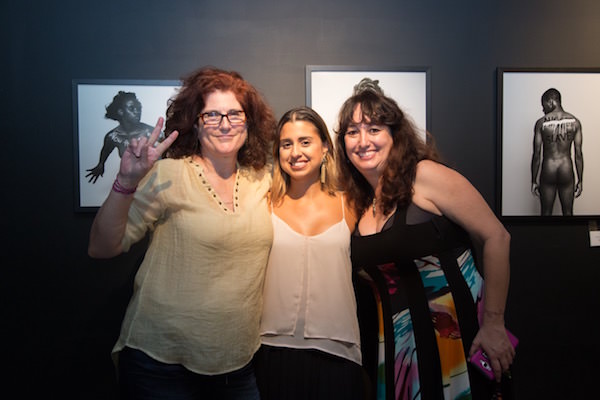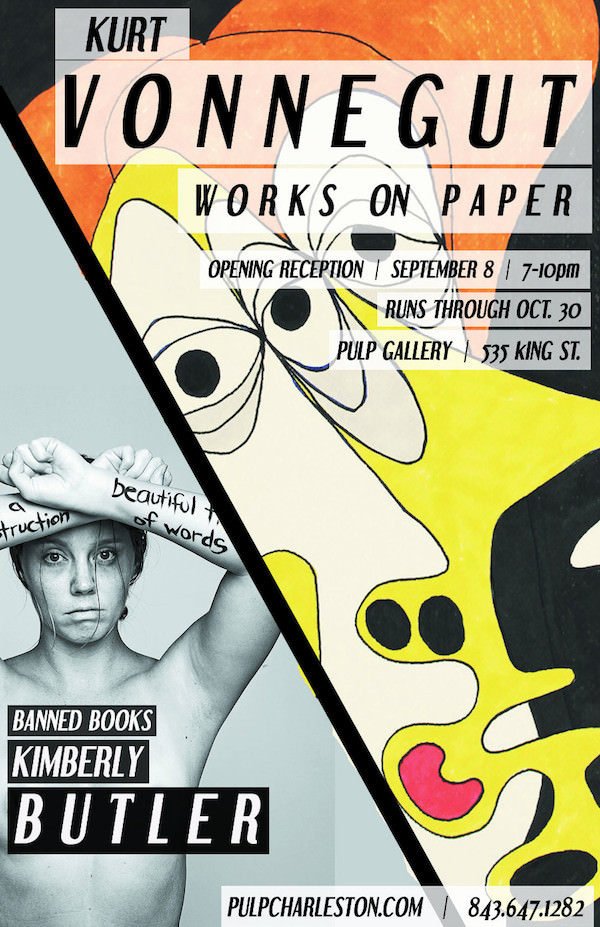Kurt Vonnegut: Works on Paper and Kimberly Butler: Banned Books Photographs at PULP Gallery and Bookstore
 |
| Front door view of PULP. Photo: Photo: Erin O’Connor |
Kurt Vonnegut: Works on Paper
 |
| Kurt Vonnegut: Works On Paper, on display at PULP. Photo: Erin O’Connor |
Best known as the literary genius behind works such as the violently absurd anti-war classic Slaughterhouse-Five and the profoundly ironic and religiously speculative masterpiece Cat’s Cradle, Kurt Vonnegut is widely held with high regard in the realm of literature. However, often overlooked are his hand-drawn illustrations, which are scattered throughout his novels and short story collections. Fortunately, someone finally thought to inquire about Vonnegut’s lost artworks. From September 8 to October 30, Vonnegut’s drawings will be available for public viewing at PULP Gallery and Bookstore free of charge.
Some of the comments I overheard while attending the opening reception of the exhibit described Vonnegut’s artwork as being “abstract” and even “Picasso-eque”. Certainly, the artists share similar artistic styles in that they both have a liking for geometric shapes and striking colors. However, Vonnegut’s illustrations–like his publications–are nothing if not uniquely devised. One of my favorite works displayed in the exhibit features a barren tree, with branches veining out in all directions. Vonnegut has titled the work, A Tree Trying to Tell Me Something. An open birdcage, a vase that seems to be devouring its flowers rather than nourishing them, and Vonnegut’s oddly symmetrical interpretation of a nudist beach are among the other works that made an impression on me. Still, my very favorite piece had to be Kurt Vonnegut’s self-portrait, which shows him saying the words, “I just as soon would have skipped it all.” With one line of text, he managed to rise from the dead and make me question the sincerity of my surroundings. Classic Vonnegut. (As an aside, I’m seriously considering getting this particular piece tattooed on my body.)
Beautifully displayed in a horseshoe at the PULP Gallery, the exhibit Kurt Vonnegut: Works on Paper is certainly worth taking the time to go and see. The illustrations are stunning and thought provoking, not to mention direct insight into the mind of the creative genius behind several beloved literary classics.
Kimberly Butler: Banned Books
 |
| Banned Books by Kimberly Butler, on display at PULP. Photo: Erin O’Connor |
In addition to Works on Paper, photographer Kimberly Butler presents her exhibit Banned Books at the PULP Gallery. This stunning display of photographs manages to ask questions, provide answers, and make strong declarations all at the same time. The pictures feature quotes from novels that have been banned from schools painted on the naked bodies of various models. By taking sensitive topics such as religion, sexuality and race and painting them on nude models, Butler attacks our society’s unspoken decision to avoid such relevant issues.
I was given the opportunity to speak with Kimberly Butler about her artwork, and she gave me some insight into her artistic thought process. When asked about her inspiration for the collection, Butler recounted a story from her past, where she was watching a film adaptation of Ray Bradbury’s Fahrenheit 451. The story takes place in a dystopian society in which all books have been banned. However, at the end of the story, the story’s protagonist finds that the stories have managed to be preserved by several individuals who have committed the texts to memory. In Butler’s words, “Books never die.” Certainly this sentiment is expressed in the chilling artwork that Butler creates. From the expression on the faces of the models, to the ingeniously selected quotes, to the powerful positions in which the photo’s subjects are placed, Butler is effective in delivering her strong and deliberate message.
 |
| Kimberly Butler (left) hangs out with some PULP-goers. Photo: Erin O’Connor |
When I asked exactly what reactions she hoped would result from her exhibit, she frankly replied, “I hope it will piss some people off.” If the abundance of large prints of naked bodies displayed publicly wasn’t enough to achieve this aspiration, the quotations she selected from the literature certainly are. One example that had Butler particularly upset was the replacement of the “n-word” by the word “slave” in Mark Twain’s, Huckleberry Finn. Butler practically fumed with anger as she explained that, not only did they not have Mark Twain’s permission to change the language, but also, “it’s the word we used then, and it’s the word we use now.” Without arguing whether or not we should use the “n-word”, it is a term that’s ever present in our society, and Butler finds it particularly offensive that the media would attempt to undermine that fact. “They (the media) aren’t telling the truth,” Butler claimed. This claim seems to be the underlying root of Butler’s frustration, and thus the inspiration for this incredible collection of artwork.
There is no way to describe Butler’s work that would do it justice. It’s a breathtaking exhibit that’s sure to open your eyes to the politics of aesthetics. As Butler herself put it, “There’s only one truth–and we get it through art.”


